#myocastor
Photo

Nutria
24 notes
·
View notes
Text

Rei found a coypu in the river
#rei ayanami#rei#evangelion#evangelion 3.0+1.0#rebuild of evangelion#nutria#coypus#myocastor#coypu#myocastor coypus#doodle#clip studio#clip studio paint
24 notes
·
View notes
Text



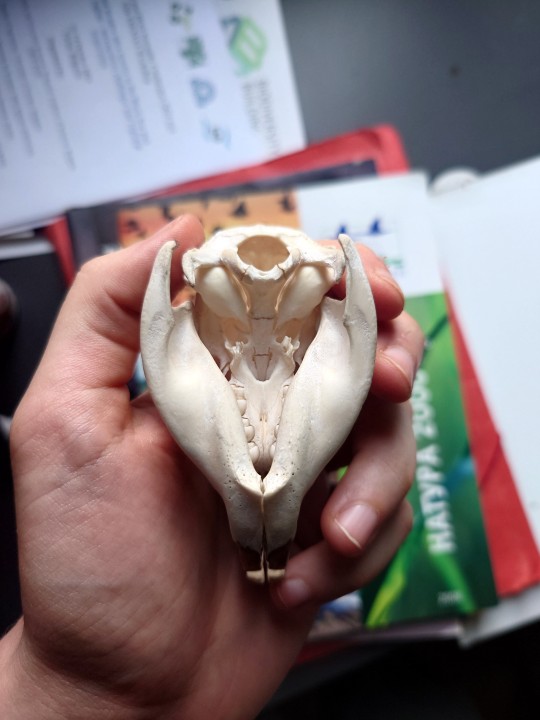
Myocastor coypus (Molina, 1782)
Mammalia, Rodentia
♀ juv. or subad.
Locality: Sofia Zoo (captive)
Perished from piercing wound during
interspecies conflict on 29.10.2023
--------------------------------------------
Gifted by a friend who works at the zoo after he saw a talk I did on beavers! tysm Andy! He have it to me mostly clean, but I finished the last bits off (took like a month and a half too hah) v happy with how it turned out!
#leaf-thief oc#zoology#skull#skulls#nutria#myocastor coypus#biology#bones#bone cleaning#rodents#rodentia#mammalia
4 notes
·
View notes
Text

THE BIG RAT !! SO SILLY

ROUND AND WHISKERS 👍👍👍

3 of them????
0 notes
Text
The Myopotamus Coypus (like a beaver, but with a round tail) is well known from its fine fur, which is an object of trade throughout the tributaries of La Plata.
"Journal of Researches into the Natural History and Geology of the Countries Visited During the Voyage of H.M.S. Beagle Round the World, 1832-36" - Charles Darwin
#book quote#the voyage of the beagle#charles darwin#nonfiction#myopotamus coypus#myocastor coypus#fur trade#la plata
0 notes
Text

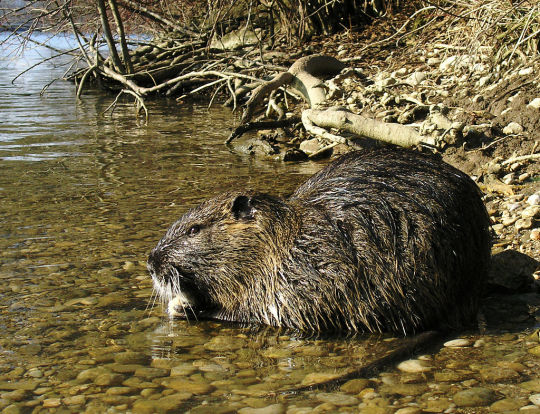
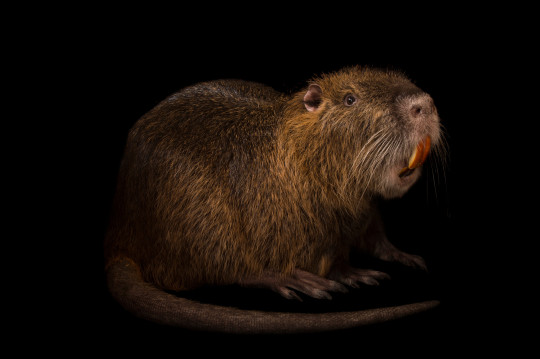
Noticing the Nutria
The nutria, or coypu (Myocastor coypus) is a species of rodent native to the lakes and wetlands of South America, from Bolivia to Tierra del Fuego in Chile and Argentina. It is often confused with capybara or beavers due to its size and shape; adults are typically 4-9 kg (9-20 lbs) and 40-60 cm (16-24 in) long. The fur is brown, and like its look-alikes the coypu has four large incisors that are a distinct orange color, which comes from the high amounts of iron in the enamel. M. coypus can be distinguished from other large rodents by its tail, which is long and slender-- ideal for swimming.
In addition to its thick three layers of fur, the nutria has several adaptations for a semi-aquatic life. Four of the five digits on the hind feet are webbed, and they have strong lungs that allow individuals to remain submerged for up to ten minutes. Females have nipples high on their flanks, to allow their young to suckle while they float in the water. The coypu's large teeth are used to feat on aquatic plants, as well as small animals like snails and mussels. Both the teeth and the tail are also used to deal with predators; when evading birds of prey, alligators, garfish, and other mammals the nutria will try to swim away, while the teeth can be used to deter turtles, snakes, and smaller predator fish.
In their native habitat, survival rates for M. coypus are extremely low. 80% of nutrias die within their first year, and it's rare for individuals to exceed three years of age in the wild. Males reach sexual maturity at 4 months old, while females can become sexually mature at only 3 months. Nutria are highly social, and can live in groups of 2-13 individuals, usually a large male and several mates and their litters. These groups construct platforms out of vegetation and burrows in muddy river banks- reaching up to 15 m (50 ft)-- where they mate and raise their young.
Mating occurs year-round, and it's not uncommon for a female to have 2 or 3 litters in a year. Gestation of a litter lasts about 130 days, after which she gives birth to an average of 5-7 young, though it may be as many as 14. Baby coypu are born with their eyes open, and can swim and feed on vegetation only hours after birth. These pups only remain with her for 4-8 weeks, after which they are weaned and either join the group as adults or leave to find another colony. This allows their mother to prepare herself for another litter-- an important task, as she is ready to become pregnant again the day after giving birth.
Conservation status: The IUCN has yet to rate the nutria, although studies have suggested they're disappearing from their native rivers and lakes. Conversely, M. coypus is highly invasive in parts of North America, Europe, Asia, and Africa, where it has been introduced by fur ranchers.
If you like what I do, consider leaving a tip or buying me a kofi!
Photos
Greg Lasley via iNaturalist
Petar Milošević via Wikipedia
Joel Sartore
#nutria#coypa#Rodentia#Echimyidae#spiny rats#rodents#mammals#wetlands#wetland mammals#lakes#lake mammals#rivers#river mammals#freshwater fauna#freshwater mammals#south america#southern south america#animal facts#biology#zoology
162 notes
·
View notes
Text

Grzimek's Animal Life Encyclopedia, vol. 11, Mammals II. 1972. Illustrated by Peter Barrett.
1.) Plains viscacha (Lagostomus maximus)
2.) Southern viscacha (Lagidium viscacia)
3.) Long-tailed chinchilla (Chinchilla lanigera)
4.) Prehensile-tailed hutia (Mysateles prehensilis)
5.) Hispaniolan hutia (Plagiodontia aedium)
6.) Jamaican coney (Geocapromys brownii)
7.) Nutria (Myocastor coypus)
#rodents#plains viscacha#southern viscacha#long-tailed chinchillas#prehensile-tailed hutias#hispaniolan hutias#jamaican coneys#nutria#Peter Barrett
134 notes
·
View notes
Text
Preliminaries

Information about contestants below!
Nutria or coypu (Myocastor coypus)
Nutria is a large, herbivorous, semiaquatic rodent. It lives in burrows alongside stretches of water and feeds on river plant stems. It somewhat resembles a very large rat, or a beaver with a small, long and skinny hairless tail. Three distinguishing features are a white patch on the muzzle, webbed hind feet, and large, bright orange-yellow incisors.
Nutria are found most commonly in freshwater marshes and wetlands. They either construct their own burrows, or occupy burrows abandoned by other animals. They are also capable of constructing floating rafts out of vegetation. Nutria live in partially underwater dens. One male will share a den with three or four females and their offspring.
Nutria can live up to six years in captivity, but individuals uncommonly live past three years old. It is considered an invasive species in Europe.
Desmarest's hutia or Cuban hutia (Capromys pilorides)
It is the largest living hutia. It has thick, coarse fur which extends to the tip of the tail. The colour of the body fur varies from black to brown, with a light sand colour and red also seen.
The Desmarest's hutia is found only in Cuba, but is widespread throughout its range. In northern Cuba, populations tend to be centred on areas where there are abundant mangroves, while southern populations tend to favour a more terrestrial habitat.
Desmarest's hutias normally live in pairs, but can be found individually or in small groups. They are diurnal and do not burrow, so during the night they rest in hollows in rocks or trees. They are omnivorous but eat mostly bark, leaves and fruit. In captivity they live for eight to eleven years.
Muskrat (Ondatra zibethicus)
They are covered with short, thick fur of medium to dark brown color. They have long tails covered with scales. To aid in swimming, their tails are slightly flattened vertically, a shape that is unique to them. Muskrats spend most of their time in the water and can swim underwater for 12 to 17 minutes.
The muskrat mostly inhabit wetlands. They live in families, consisting of a male and female pair and their young. They build nests that are often burrowed into the bank with an underwater entrance. Muskrats feed mostly on cattail and other aquatic vegetation but also eat small animals.
Their bodies, like those of seals and whales, are less sensitive to the buildup of carbon dioxide than those of most other mammals. They can close off their ears to keep water out. In some European countries the muskrat is considered an invasive species.
19 notes
·
View notes
Text
otters
Los lutrinos (Lutrinae), conocidos comúnmente como nutrias, son una subfamilia de mamíferos carnívoros de la gran familia Mustelidae. Existen trece especies de nutrias repartidas en siete géneros,1 con una distribución de la población prácticamente mundial. El término nutria,2 sobre todo en América del Sur, designa también a otro animal, el coipo o quiyá (Myocastor coypus), de costumbres predominantemente acuáticas, pero que es un roedor.
Características
Poseen un tupido pelaje impermeable que les permite conservar el calor de su cuerpo. Son grandes nadadoras y pueden cerrar sus fosas nasales bajo el agua, pudiendo permanecer bajo el agua hasta cuatro minutos sin salir a la superficie para respirar. Realizan movimiento de patas y cola, de arriba abajo, cuando se desplazan por el agua a gran velocidad. Solo utilizan sus patas delanteras cuando nadan lentamente. En el agua pueden alcanzar velocidades de hasta 12 km/h.

2 notes
·
View notes
Photo

What looks like a cross between a beaver and a rat and has happily adjusted to life far from its native South America? Give up? The answer, dear friends, is nutria (Myocastor coypus).
21 notes
·
View notes
Text
Très chouette billet sur mes chimères sauvages (et belle collection de créatures!!) sur le blog Montmartre Secret… Merci 🙏 🙏🙏
#streetart#codexurbanus#graffiti#codex#codex urbanus#street art#arturbain#picoftheday#vandal#streetartparis#paris graffiti#montmartre#arteurbano#street artist#graffitiart#paris street art#streetarteverywhere#parisstreetart#streetartists#bestiary
2 notes
·
View notes
Text
Un estudio pionero liderado por el CSIC analiza la exposición de los hábitats europeos al impacto de 94 especies de animales y plantas invasoras e identifica regiones críticas para la conservación
El coipu, ‘Myocastor coypus’, es una de las especies invasoras estudiadas. / Matthieu Berroneau
Un estudio internacional, publicado en Nature Communications, alerta sobre los riesgos que suponen las especies invasoras para la provisión de servicios de los ecosistemas en toda Europa. Por primera vez se ha realizado un análisis espacial exhaustivo sobre la exposición de los hábitats europeos a la invasión, lo que ha permitido identificar regiones críticas para la conservación de servicios vitales para el medioambiente, la salud y el bienestar de la sociedad. El trabajo está liderado por el Instituto Pirenaico de Ecología (IPE-CSIC), del Consejo Superior de Investigaciones Científicas (CSIC), y cuenta con la participación de científicos de nueve centros internacionales.
La investigación se ha centrado en evaluar los riesgos actuales y potenciales que plantean 94 especies invasoras -32 plantas terrestres, 29 animales terrestres, 20 animales de agua dulce y 13 plantas de agua dulce-, todas ellas incluidas en la Lista Europea de Especies Invasoras preocupantes para la Unión y el Catálogo Español de Especies Exóticas Invasoras. Algunos ejemplos bien conocidos en España incluyen la avispa asiática, la rana toro, el jacinto de agua, el visón americano, la polilla del boj o la hierba de la Pampa. Para evaluar dichos riesgos se ha utilizado la información más reciente sobre la presencia de estas especies, junto con modelos estadísticos que predicen su expansión futura, para evaluar la exposición presente y futura de siete servicios ecosistémicos clave: mantenimiento del hábitat, retención de nitrógeno, la retención del suelo, el control de inundaciones, la provisión de cultivos y madera, y el turismo al aire libre.
“Este listado incluye especies no-nativas con impacto adverso demostrado sobre la biodiversidad y que, por lo tanto, constituyen una prioridad en su gestión”, explica Belinda Gallardo, científica titular del IPE-CSIC e investigadora principal del estudio. “La regulación europea exige a los estados miembros desarrollar planes de gestión adecuados al nivel de invasión y vulnerabilidad de cada estado”, añade.
Una amenaza creciente
El estudio prevé un aumento promedio del 77% en las áreas susceptibles de ser afectadas por especies invasoras en toda Europa, lo que subraya la creciente amenaza que suponen. Además, el trabajo identifica regiones específicas que combinan un alto riesgo de invasión con una alta provisión de servicios ecosistémicos. Estas regiones, que cubren entre el 0% y el 13% de la superficie de Europa dependiendo del servicio analizado, se señalan como prioridades para la conservación.
La investigación destaca una mayor vulnerabilidad en servicios como la retención de nitrógeno y la provisión de cultivos, frecuentemente ubicados en áreas que sufren el impacto de actividades humanas, donde la introducción de especies invasoras es más probable. Este es el caso de plantas acuáticas como el camalote, la cola de zorro y la lechuga de agua, las cuales forman densas colonias que afectan a la depuración y explotación del agua precisamente en las zonas agrícolas y urbanas que más lo necesitan del centro y sur Europa. Y animales como el coipu, el mapache o el coati, afectan a la producción de alimentos en Centroeuropa además de ofrecer un reservorio de enfermedades que afectan a la salud humana.
Si no se toman medidas por parte de los respectivos estados, señalan los científicos, las zonas ricas en biodiversidad y servicios ecosistémicos podrían volverse aún más vulnerables a medida que las especies invasoras se expandan y lleguen otras nuevas, tendencia que se verá intensificada por el cambio climático y el aumento del comercio y turismo global.
“Observamos una clara discrepancia entre las áreas más expuestas a la invas...
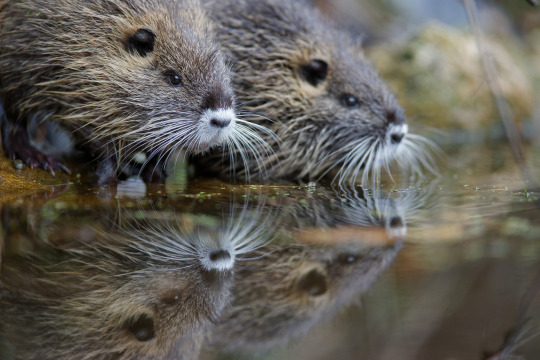
View On WordPress
0 notes
Video
Nutria "Myocastor coypus" nutria o rata tu decides familia roedores
Myocastor coypus, llamada comúnmente coipo, coipú, nutria o quiyá es una especie de roedor histricomorfo propia del sur de Sudamérica, parecido al castor. Habita en diversos tipos de humedales. El coipo es también llamado nutria, palabra que designa también a otro animal carnívoro. Es un roedor de gran talla, pesa entre 4 y 10 kg. Alcanza 40 a 60 cm de longitud corporal, con una cola de 30 a 45 cm. Su pelaje exterior es en tonos marrón oscuros y brillantes, con una capa de pelo gris debajo. Presenta un parche de pelaje blanco en el hocico e incisivos anaranjados brillantes, sus ojos y orejas son de reducido tamaño. El áspero pelo superior recubre un vello inferior de considerable valor comercial. Tiene sus patas con membranas interdigitales; su cola es larga y escamosa. Es el roedor más grande de Chile. Tiene una interesante adaptación a la vida acuática que consiste en la posición de sus mamas, colocadas a lo largo de ambos lados, en el dorso, de manera que la hembra nada mientras da de mamar a sus crías.
0 notes
Photo
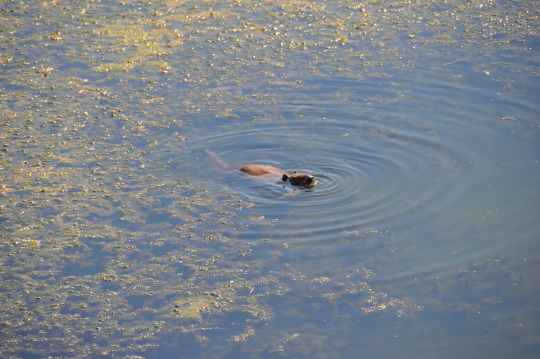
chill coypu
#leaf-thief oc#coypu#myocastor coypus#capybara#swamp#swamplife#ecology#zoology#biology#invasive species
6 notes
·
View notes
Photo

Nutria
7 notes
·
View notes
Photo

Shaped like a friend.
#coypu#nutria#rodent#animal art#myocastor#mixed media#brush marker#coypu are very cute#it's a pity they are so bad for the dikes/embankments in my country
6 notes
·
View notes